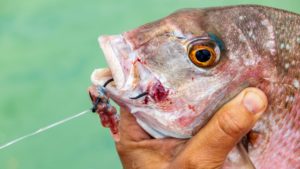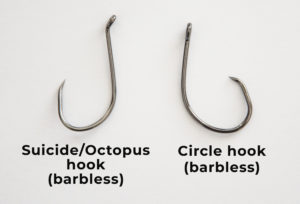
Fishing hooks are the first point of contact with fish and there are a few ‘givens’ when it comes to hooks for success. They must be sharp, they need to be picked for purpose and they must be rigged properly – that is, the knot must be tied well and in some cases, some knots are more appropriate than others.
The other important consideration is what impact your hook choice has on the fishery and environment. There aren’t many hooks for inshore species that are stainless steel but many brands have special coatings to resist rust and devaluing of their investment. High carbon hooks have high strength but can be more susceptible to oxidisation. These are better for the fish if the fish escapes with the hook still attached because it will rust out quicker. There are ways to reduce or eliminate oxidisation e.g. Once you have used the hook, do not put it back in the packet with the unused ones. Put it in a separate container with some vegetable oil or silicone to arrest any degradation.
Bait fishing hooks
Suicide / J style hooks are very common for bait fishing and are offset in shape. These hooks can be good for hooking fish and require the angler to strike to set the hook. These are popular and what most bait fishers have grown up with, learning how to hook fish with quick reflexes.
The downside is that these hooks are deadly when swallowed by fish, which is ok if you will keep the fish and it doesn’t escape by breaking the line. The best approach to using these hooks is to use large sized hooks, 7/0 or larger and don’t leave the rod unattended. Even 28cm (illegal) sized snapper can manage to scoff it down and get gut hooked if given enough time.
It is common for fishers to let the fish run with the bait and then strike. We would discourage this practise if it results in gut hooking. Sometimes the fish are cautious, but sometimes it’s because the fish are just too small and can’t fit the bait in their mouth. Best to strike by letting the fish turn (drop the rod tip before striking) instead of disengaging the reel and giving it time to get gut hooked.

Circle Style Hooks
There are a few variations of circle style hooks and studies show non-offset hooks are best at lip hooking fish. These styles of hook are good for bait because fish will be hooked most often in the lip or jaw. Circle hooks also come in offset styles as well. We would recommend carefully bending into a straight line with a vice or a pair of pliers if you can to reduce the chance of gut hooking a fish. ,
Circle hooks require a different approach to striking. The basic theory is that the hook will slide into the corner of the jaw as the fish moves away with the bait so it’s best to lower the rod a little and when the fish has the bait in its mouth, to slowly lift the rod. Another way is to simply start winding the reel without a vicious jerk of the rod and this can slide the hook into the jaw or lip.


